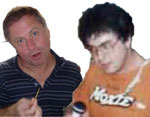Clams Ahoy!
Everything you always wanted to know about Clams but were afraid to ask!!
Quahog Clams
Quahog clams are also known as quahaug clams. Both are pronounced “CO-hog.” The divergent spellings result from the fact quahog is an Algonquin word. The Algonquin language makes use of sounds, phonemes, not found in English. It is believed the word quahog was first used by the Narragansett or Pequot, Algonquin tribes native to what is now Rhode Island.
Edible clams are divided into two categories: hard-shell and soft-shell. Quahogs are part of the hard-shelled clam family, and are the largest clams eaten on the East Coast. There are actually two species of quahogs, and they look remarkable similar despite being different clam species.
The Ocean Quahog, Arctica islandica, it is often confused with the smaller Quahog, Mercenaria mercenaria, which is also called a Littleneck or Cherrystone depending on size. The ocean quahog ranges in size from 4” to 8” in diameter. Mercenaria mercenaria are smaller and their common name depends on their size. Cherrystones are 2 1/2” to 4” and often served raw on the half-shell with cocktail sauce. Littlenecks are smaller quahogs, anything smaller than a cherrystone. In some jurisdictions, it is illegal to harvest littlenecks because they are considered seed crop. Despite the two species we discuss them together below as they look and taste quite similar.
 Hard-shelled clam meat is tougher than soft-shell or
steamer clams. Littlenecks clams are the least chewy; quahogs are so chewy
they are not typically eaten whole. Instead quahog meat is used whenever
substantial amounts of clam meat are required for industrial food
production, and for clam-based entrees that involve more than single clams
eaten at one time. The meats are separated from the shells and then
tenderized, most often through a combination of pounding or pummeling with a
hard object and marination. Both break down the tough protein fibers that
make the sweet clam flesh more difficult to enjoy.
Hard-shelled clam meat is tougher than soft-shell or
steamer clams. Littlenecks clams are the least chewy; quahogs are so chewy
they are not typically eaten whole. Instead quahog meat is used whenever
substantial amounts of clam meat are required for industrial food
production, and for clam-based entrees that involve more than single clams
eaten at one time. The meats are separated from the shells and then
tenderized, most often through a combination of pounding or pummeling with a
hard object and marination. Both break down the tough protein fibers that
make the sweet clam flesh more difficult to enjoy.
The most famous entrée to make use of hard-shell clam meats is baked stuffed clams. These are available not just at seafood restaurants, but at many Italian eateries particularly those serving southern Italian (“red sauce”) cuisine. The chef first steams the clams, tenderizes the meats then dices them into pieces about 1/8” or so. These are mixed together with bread crumbs and flavored with garlic, sometimes sage and other stuffing-type seasonings. When the mix is complete, it is placed by tablespoon into clean quahog half-shells in symmetrical heaps. Each shell heap is then often topped with 1-2 inch strip of bacon. The shells are arranged on flat pans, then baked in the oven at 350 degrees F. When the bacon on top of the clams is cooked, the baked clams are taken from the oven. Chefs know to wait at least ten minutes before serving baked stuffed clams. Hard clam shells are 100% carbonate, and retain heat for some time.
Another popular quahog dish is clam pie. This entrée is a Cape Cod/Maine staple, and sufficient for dinner without side dishes needed. A good clam pie is gooey, like apple pie, and replete with tasty clam meats, cubed potatoes, carrot chunks, sometimes peas and just enough flour to hold the mix together. Just as the chief danger to successful baked stuff clams is too much breading, a clam pie can be ruined by too much flour. Only the minimum amount of flour should be used. It is also important not to skimp on the crust. Excellent clam pie makes use of a scratch crust. If time does not permit, one of the better commercially-available refrigerated pie crusts will do.
Quahog shells are best known for their bluish shading. Blue-purple pieces of the shell are polished and used to make jewelry today, just as in pre-Columbian times. In Alqonquin, the word quahog means “white.” Wampum, an Indian jewelry sometimes used as currency, is made from the white portion of quahog shells. The purple part of the shell, in polished form is known in Algonquin as suckanhock. The most common traditional form for both wampum and suckanhock was beads. Today the white and purple shell is most often polished into small flat circles. These circles are made into earrings, cuff links and sometimes necklace ornaments.
Crushed quahog shells are sometimes used for driveways in coastal regions of the Northeast United States. When broken into pieces, hard clam shells are razor-sharp. If you walk across them, wear shoes. If the shells are unbroken, it is OK to walk on them, in fact this is not a bad way to locate quahogs to eat. At high or medium tide, it is easy to identify the presence of hard-shell clams when swimming. All you need do is stand on the sea floor, and pay attention to the bare soles of your feet.
 Hi,
we are Ted and John, just two guys who love Clams and other seafood.
Hi,
we are Ted and John, just two guys who love Clams and other seafood.